|
Oily aromatics

Massage their oily foliage and you’ll get a rich aroma throughout the year - whether it’s the lavender, sage, rosemary or thyme. This oily coating is a sunscreen and many of the plants are either silver, a colour that doesn’t absorb much heat, or have needle-like leaves to cut down on water loss. These plants also tend to have an evergreen presence. On scorching days in high summer you won’t have to touch the foliage at all, it will waft through the air providing an aromatherapy session for the gardener that’s both relaxing and soothing. However any aromatic plant must have a sunny position in well-drained soil. It will sulk in any shade.
English lavenders
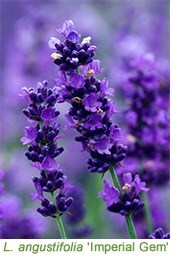 No wonder these plants were prized by the Romans, often for their antiseptic properties. They brought them here and they’ve been here ever since, becoming an essential part of the English garden. Lavender oil was added to Roman bath water as a soothing and relaxing addition - the name comes from the Latin ‘lavare’ to wash. Lavandula angustifolia has been prized here for centuries and has become known as English lavender. It’s the hardiest of all, with narrow leaves and summer flowering short spikes of flower held just above the foliage. No wonder these plants were prized by the Romans, often for their antiseptic properties. They brought them here and they’ve been here ever since, becoming an essential part of the English garden. Lavender oil was added to Roman bath water as a soothing and relaxing addition - the name comes from the Latin ‘lavare’ to wash. Lavandula angustifolia has been prized here for centuries and has become known as English lavender. It’s the hardiest of all, with narrow leaves and summer flowering short spikes of flower held just above the foliage.
There are several named forms including the classic purple flowered ‘Hidcote’, a variety brought to England by Major Lawrence Johnstone of Hidcote Manor in Gloucestershire in the 1920s. This came from France and Thomas Carlile of Loddon’s Nursery in Twyford, Berkshire once had exclusive rights to propagate - such was its reputation. It’s a stronger colour, a deep purple, and it’s the best lavender for a hedge because it’s low-growing, compact and showy.
A newer English lavender called ‘Imperial Gem’, selected by Norfolk Lavender in the 1960s, is taller in habit with thicker spikes and this is the best deep blue English lavender. The more violet ‘Munstead’ will give you a softer look.
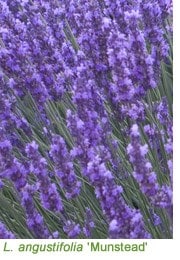 The English lavenders, always listed under L. angustifolia, are the hardiest of all - and the longest lived. A correctly pruned lavender of this type will look lovely and vigorous twenty years on, but will then need replacing. The flowers of English lavender appear during Wimbledon fortnight or there abouts and, if you wish to dry them, this is the time to pick and bunch them. Hang them upside down to dry in a warm but dark place. Many use their wardrobes. If you’re using lavender bushes as an accompaniment to roses, you can cut away a third of the growth in early May to delay the flowering time by a month so that the lavender follows on after the roses. This is the common practice at The National Trust’s Mottisfont Abbey in Hampshire. The English lavenders, always listed under L. angustifolia, are the hardiest of all - and the longest lived. A correctly pruned lavender of this type will look lovely and vigorous twenty years on, but will then need replacing. The flowers of English lavender appear during Wimbledon fortnight or there abouts and, if you wish to dry them, this is the time to pick and bunch them. Hang them upside down to dry in a warm but dark place. Many use their wardrobes. If you’re using lavender bushes as an accompaniment to roses, you can cut away a third of the growth in early May to delay the flowering time by a month so that the lavender follows on after the roses. This is the common practice at The National Trust’s Mottisfont Abbey in Hampshire.
Pruning English lavender needs to be done in August to encourage lots of bushy new growth in September. Be radical, cut it back hard to within three to six inches (7 - 15cm) so that the lavender regenerates before winter arrives. In mild winters the bushes can carry on growing, but they can be trimmed again in April should this happen. After a hard winter, there may be dead wood. Cut this away to the new shoots in mid-April.
Lavendins
 The next hardiest group of lavenders, called lavendins, are hybrids listed as Lavandula x intermedia. They are widely grown in France for their oil and they are much larger and more robust and also flower later. They make rounded loose bushes and the long stems are topped with tapering flower spikes in late-summer, rather than the thick spikes borne by English lavender in early July. ‘Grosso’ has a distinct habit because it splays its purple-blue flowers out, rather like quills on a porcupine. The foliage is much greener than most lavenders and it can look out of place among too many silvers. However it is a fine specimen plant for sunny borders. It’s named after the French farmer who spotted it in 1972, a M. Pierre Grosso, and it’s now widely grown throughout the world because of its long-lived qualities and the abundance of camphor-like oil it produces. This is used to make pot pourris, detergents, washing powders and softeners. English lavender oil is the one used in perfumes and cosmetics - because it’s more refined. The next hardiest group of lavenders, called lavendins, are hybrids listed as Lavandula x intermedia. They are widely grown in France for their oil and they are much larger and more robust and also flower later. They make rounded loose bushes and the long stems are topped with tapering flower spikes in late-summer, rather than the thick spikes borne by English lavender in early July. ‘Grosso’ has a distinct habit because it splays its purple-blue flowers out, rather like quills on a porcupine. The foliage is much greener than most lavenders and it can look out of place among too many silvers. However it is a fine specimen plant for sunny borders. It’s named after the French farmer who spotted it in 1972, a M. Pierre Grosso, and it’s now widely grown throughout the world because of its long-lived qualities and the abundance of camphor-like oil it produces. This is used to make pot pourris, detergents, washing powders and softeners. English lavender oil is the one used in perfumes and cosmetics - because it’s more refined.
Lavendins are hardy in well-drained soil, but they flower too late to get a short back and sides in early August. Instead, trim them back after flowering to shape them into roundels, cutting into the top of the foliage in September if possible. They can form good winter silhouettes and, should you want them to shine in winter, cut into them by mid-September and shape them a little tighter into roundels. In hard winters they can suffer damage - just cut any dead wood away in mid-April and they will recover.
French (or Spanish) lavenders
 The earliest lavenders to flower are those with tufted petals at the top of the flower spike and these are often referred to as French or Spanish lavenders. The most elegant of all is Lavandula pedunculata subsp. pedunculata, an upright lavender with long slender leaves and fat flowers topped by several long petals (bracts to the botanist), that rise upwards by almost two inches. This needs a hot spot and minimal pruning, because it’s vulnerable in cold winter. However it is the most beautiful lavender and the most useful grown as a single specimen in a sunny border, or in a container. Give it a fleece cover in winter in colder areas. Prune these French lavenders after their main May or June flush, and then allow them free reign to grow. Always take off the spent flowers as they fade though, because they will rot in winter and may spread infection to the rest of your plant. After the worst of winter is over, take off any dead tips and then allow the lavender to grow and flower. The earliest lavenders to flower are those with tufted petals at the top of the flower spike and these are often referred to as French or Spanish lavenders. The most elegant of all is Lavandula pedunculata subsp. pedunculata, an upright lavender with long slender leaves and fat flowers topped by several long petals (bracts to the botanist), that rise upwards by almost two inches. This needs a hot spot and minimal pruning, because it’s vulnerable in cold winter. However it is the most beautiful lavender and the most useful grown as a single specimen in a sunny border, or in a container. Give it a fleece cover in winter in colder areas. Prune these French lavenders after their main May or June flush, and then allow them free reign to grow. Always take off the spent flowers as they fade though, because they will rot in winter and may spread infection to the rest of your plant. After the worst of winter is over, take off any dead tips and then allow the lavender to grow and flower.
In the wild (and when established) lavenders rely on a deep root system that can go down several feet. A newly planted lavender will not have had enough time to develop a deep root system and it must be watered in dry spells for the first growing season - between May and August. Most aromatic plants will also need nurturing in their first summer, despite being drought tolerant once established.
Agastaches

Lavenders are fabulous additions to the summer garden, partly because of their upright profile and linear foliage. You get the same vertical presence with another aromatic plant called Agastache and recent Dutch breeding has produced two crackers for the border. 'Blue Fortune’, a cross between A. rugosa (Korean Mint) and A. foeniculum (an American hyssop), was bred and selected by Gert Fortgens of the Arboretum Trompenberg in Rotterdam in the Netherlands. This has thick blue bottlebrushes and nettle like (though non-stinging) foliage that smells of mint. It’s the perfect partner for orange heleniums, but needs a warm position to grow away in spring.
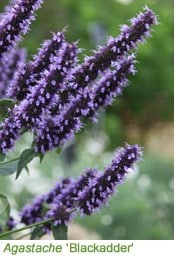 Agastache ‘Blackadder’ is more Kate Moss than stubby bottle brush, with long slender spikes that display a mixture of deep black and purple as they rise through the border on slender stems. Hybridised by Coen Janssen, also from the Netherlands, and probably from the same A. rugosum and A. foeniculum cross, this provides rare hints of dark blue in a late summer border in exactly the same way that Aconitum ‘Spark’s Variety’ does. The flowers of ‘Blue Fortune’ and ‘Blackadder’ are sterile so they last a huge time in the border, from summer until the frosts, without producing stray inferior seedlings. And there’s always that hint of aniseed, liquorice and mint in the air on a hot day, a refreshing aroma as you work away in the garden. Agastache ‘Blackadder’ is more Kate Moss than stubby bottle brush, with long slender spikes that display a mixture of deep black and purple as they rise through the border on slender stems. Hybridised by Coen Janssen, also from the Netherlands, and probably from the same A. rugosum and A. foeniculum cross, this provides rare hints of dark blue in a late summer border in exactly the same way that Aconitum ‘Spark’s Variety’ does. The flowers of ‘Blue Fortune’ and ‘Blackadder’ are sterile so they last a huge time in the border, from summer until the frosts, without producing stray inferior seedlings. And there’s always that hint of aniseed, liquorice and mint in the air on a hot day, a refreshing aroma as you work away in the garden.
And other bee-pleasers

Bees are never far away from aromatic plants because they often produce blue flowers, the favoured flower colour of bees. The nectar is super-strength too, containing masses of sugar to lure in the bee and butterfly. Thymus ‘Silver Posie’ is a marvellous edger to a hot spot with tiny pink flowers held above even tinier cream and green leaves. The sage is another suspect, and the purple-leaved sage, Salvia officinalis ’Purpurascens’, has damson coloured foliage that deepens to almost black in hot summers along with deep blue flowers. This will add depth to any silvery border and you can use this sage in cooking.
 You should also include Origanum laevigatum ‘Herrenhausen’ because this August-flowering perennial will lure in every bee and butterfly with its sugar-packed nectar. The two-tone flowers are a cool pink set in purple and the slender stems contain lots of individual flowers that stay looking fresh - whatever the weather. The slightly crinkled, dark green foliage supports the wands of flower well and a lacy, black seed head follows. It rarely throws seedlings, a bonus because most marjorams and origanums tend to be a little too generous on that front. You should also include Origanum laevigatum ‘Herrenhausen’ because this August-flowering perennial will lure in every bee and butterfly with its sugar-packed nectar. The two-tone flowers are a cool pink set in purple and the slender stems contain lots of individual flowers that stay looking fresh - whatever the weather. The slightly crinkled, dark green foliage supports the wands of flower well and a lacy, black seed head follows. It rarely throws seedlings, a bonus because most marjorams and origanums tend to be a little too generous on that front.
Once established these aromatic plants will never need watering, saving precious resources and time. In return you’ll get the buzz of bees, showers of butterflies and a swathe of silver to soften summer.
|
Five things to do
 |
Take cuttings

Take insurance cuttings of pinks, penstemons and tender plants (such as pelargoniums) in July and early August. Fill a small seed tray with coarse horticultural sand and water it well. Take the cuttings in the cool of the day, choosing non-flowering side shoots about two inches (5cm) in length. If there are flower buds, pick them off. Trim the cuttings below a node (where the leaf joint is) and remove or reduce any large leaves to lessen transpiration. Plunge them into the sand so that two-thirds of the cutting is submerged and place the tray in a cool, shady position for several weeks. Then pot up individually into compost, such as John Innes no 1. You can also leave your cuttings in situ until next spring, although they will need protection from frost.
|
 |
Deadhead repeat-flowering roses
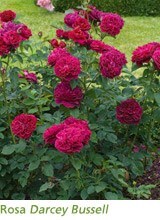 Deadhead repeat-flowering roses to encourage more. You can just nip off the spent flower right underneath, which will shorten the re-bloom time, or you may prefer to take the stem lower. Do not deadhead once and only flowering roses though because they may form hips - and they will not flower again. Deadhead repeat-flowering roses to encourage more. You can just nip off the spent flower right underneath, which will shorten the re-bloom time, or you may prefer to take the stem lower. Do not deadhead once and only flowering roses though because they may form hips - and they will not flower again.
|
 |
Be inspired
 Get out and visit good gardens because you’ll see new plants and gain new ideas. Go with a camera and a notebook. Get out and visit good gardens because you’ll see new plants and gain new ideas. Go with a camera and a notebook.
|
 |
Water
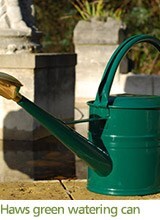 Water newly planted additions in dry weather, before they wilt. This will encourage them to root into the soil and get out of their rootball before cooler weather arrives.
Water newly planted additions in dry weather, before they wilt. This will encourage them to root into the soil and get out of their rootball before cooler weather arrives.
|
 |
Plant late bloomers

Extend your garden into autumn by planting penstemons, gauras and later asters now. Be aware that the name of the American asters has been changed to Symphyotrichum. European asters remain under Aster. God bless the botanist! |
|
|
Essential Kit for July
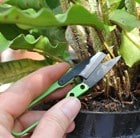
The flower dead header
£4.49 £3.49

Easy watering system
£14.99 £9.99
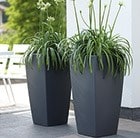
Pure soft square high pot
£59.99
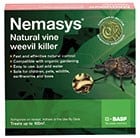
Nemasys vine weevil killer
from £8.99
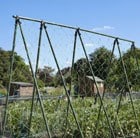
Sturdy bean plant support
£28.99

Sprayer 5 litre pressure sprayer
£24.99

Contemporary sussex trug
£59.99
|
|



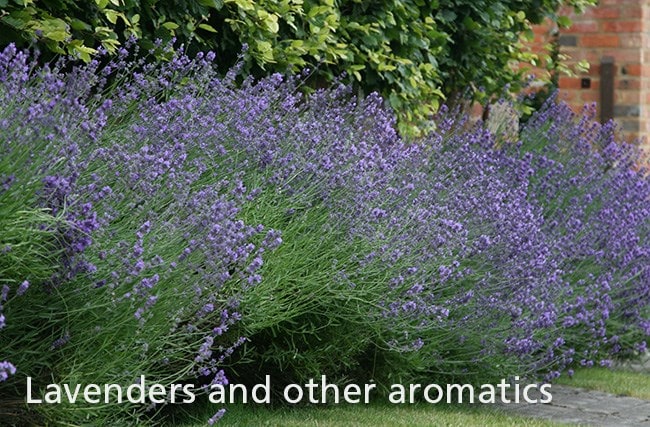






 Agastache ‘Blackadder’
Agastache ‘Blackadder’













